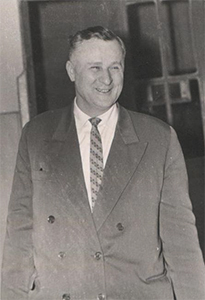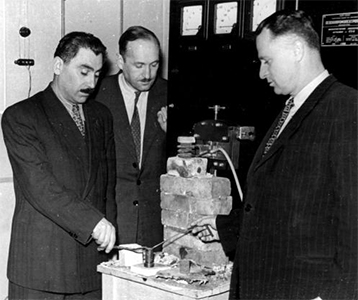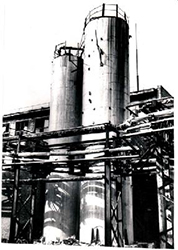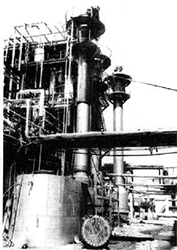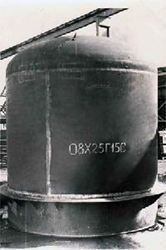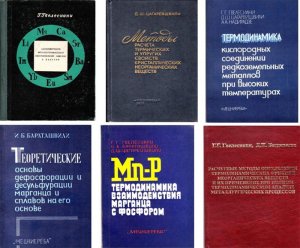Institute of Metallurgy was the only research institution of this profile in the Caucasus.That`s why it comprised so many different directions. In 1990, 42 laboratories were functioning in the Institute. Among them were Batumi corrosion laboratory with the test station, working areas in Rustavi metallurgy and Zestafoni ferroalloys plants. The Institute staff number was nearly 800. Their activities comprised metallurgy and materials science main tendencies existing worldwide. Accordingly, multifarious were scientific themes.
During many years the Institute worked in the following research directions:
- Studying, development and preparation for melting of metallurgical raw materials;
- Refine and intensify existing technologies of metallurgical production, develop new processes;
- Develop new compositions of steels and alloys, study physical and chemical fundamentals of obtaining new inorganic materials;
- Researches on chemistry and technology of high-purity materials and semiconductors, corrosion and protection of metals, physical chemistry of metallurgical processes, metallurgy of nonferrous, precious and rare metals, powder metallurgy, Self-propagating High-temperature Synthesis;
- Research on history of metallurgy of Georgia
During1945-1990 outstanding results were achieved in the following scientific directions:
State standards
In the pyrometallurgy laboratory of the Institute, in the 50-ies last century, under leadership of head of laboratory, professor Mikheil Kekelidze were started laboratory researches of Chiatura manganese ores and concentrates, which served as a basis for production classification of Chiatura manganese ores. The State Standard under former USSR Council of Minister and the Ministry of black metallurgy assigned a task to the laboratory to create state standards and quality control for ferroalloys containing manganese. Imlementation of the standards effected a large saving of the Soviet Union.
|
|
|
| Professor Mikheil Kekelidze |
Ferdinand Tavadze, Givi Mikeladze and Mikheil Kekelidze |
Closed oresmelting furnace
In 1955 in the Institute of metallurgy of the Georgian Academy of sciences, on the initiative of known Georgian scientist and engineer Givi Sh. Mikeladze, head of the electrothermics laboratory, was designed and built the first in the Soviet space 250kW power closed ore-smelting furnace. On the basis of obtained results, in Zestafoni ferroalloys plant was tested 1800kW power closed furnace, and in 1959 was implemented 2500kW power closed furnace. The annual economic efficiency gained due to the implementation of the furnace exceeded all expectations. Therefore G.Sh.Mikeladze is recognized a pioneer in the origination of closed furnaces. Under his leadership were established the optimal parameters of obtaining ferromanganese, silicomanganese, ferrosilicon, ferrotitanium. Noteworthy that in the world practice ferrochrome and silicomanganese were first received by the Georgian scientists.
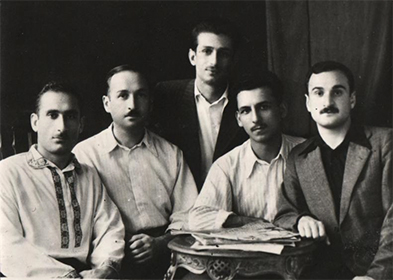
Head of electrothermics laboratory and his first followers
In 1965 by the decision of the USSR Council of ministers the laboratory of electrothermics headed by G.Sh.Mikeladze was entrusted with a task to coordinate the scientific-designing works related to closed furnaces, as well as supervise the implementation of closed furnaces in the plants all over the Soviet Union and the Institute was nominated a leading organization in aforementioned field.
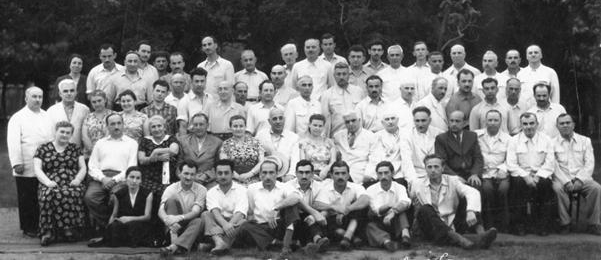
Participants of the session on the manganese production held in Zestafoni in 1958
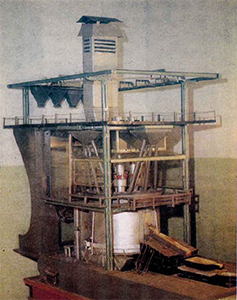
A layout of the closed furnace without lining awarded gold medal
at the XV international exhibition held in Plovdyv
* * *
Main directions of the Ferdinand Tavadze’s scientific school are the following:
Special steels and alloys. On the initiative of Academician F.N.Tavadze the investigations in the field of materials science were begun since the day of the Institute foundation. Most significant among them are: multicomponent austenite class steels, corrosion of metals, foundry, whiskers, boron and semiconductors, metal melts, self-propagating high-temperature synthesis, study of archaeologic metal. Most noteworthy is that vast majority of these directions succeeded in meeting the challenges of the time and today their development is still in progress, thanks to Ferdinand Tavadze`s inspiration.
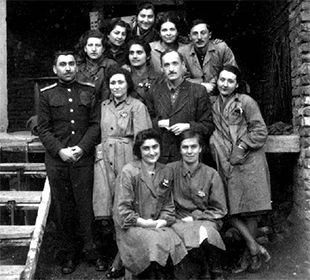
First group of metallurgists
Materials science studies – main directions of the Ferdinand Tavadze’sscientific school:
- Theory of alloys: phase transitions, relaxation phenomena, phase diagrams of multicomponent systems, studying of principles of doping, whiskers, metal melts (D.Ebanoidze, N.A.Zoidze, V.A.Pirtskhalaishvili, N.N.Luarsabishvili, G.G.Surmava, J.V.Khantadze).
- Steels and alloys: special materials, metal corrosion and protection against corrosion (S.N.Manjgaladze, T.A.Lashkhi, L.F.Tavadze), cryogenic steels (G.N.Grikurov), fire-resistant and heat-resistant alloys (O.I.Mikadze), composite materials (A.G.Mikeladze), boron and its alloys (G.V.Tsagareishvili), self-propagating high-temperature synthesis (G.F.Tavadze, G.Sh.Oniashvili).
- Foundries: intensification of melting units, precise and artistic casting technology, modification of materials, uninterrupted casting (M.D.Lanchava, A.I.Bakuradze, Sh.A.Mirotadze, Sh.D.Ramishvili).
- History of metallurgy: conservation&restoration of the archaeological metal, production technology of archaeological metallicgoods, dating of archaeological treasures (T.N.Sakvarelidze).
Monographs written under directorship of F.Tavadze
|
|
|
|
| a | b | c |
a) Hydroxylaminosulphate reservoir made of ЭП 667 grade chrome-nickel acid-resistant steel;
b) Hydrolyses made of ЭП 667 grade chrome-nickel acid-resistant steel in the Rustavi production association “Azoti” caprolactam production;
c) 7 m3 capacity evaporating boiler made of corrosion-resistant steel 08X25Г15С developed in the Institute, which was mounted for producing sulphur sodium in Pervouralsk bichromate plant;
Ladle refining of liquid steel
In the eighties of the last century, the Institute of Metallurgy was developed so-called injection method of swelling of liquid steel with inert gases, slag-forming mixtures, and powdered materials through the ladle gate’s pouring trough.
In 1987, the West German firm “Croup Polizyus” acquired a license for the use of the mentioned technological method. The 150,000 US dollars, equity percentage of the Institute, were credited to the Georgian Academy of Sciences.

Technological scheme of out-of-furnace treatment of liquid steel
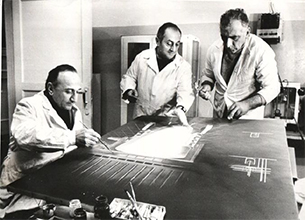
The process of designing the project
Problem of boron
In the former Soviet Union, the purification technology of boron by vertical zone-melting for the first time was developed in the Institute of Metallurgy of the Georgian Academy of Sciences and then it became possible to produce single-crystalline β-rhombohedral boron and boron stable isotopes 10B and 11B.
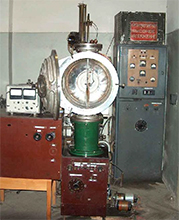
Installation of vertical zone melting by electric beam bombardment
The awarding in 1980 Prof. G.V.Tsagareishvili the George Nikoladze Prize of the Georgian Academy of Sciences for a series of works “Preparation of crystalline boron of high purity, studying its structure and properties” is considered as doubtless recognition of the research conducted in boron direction in Georgia.
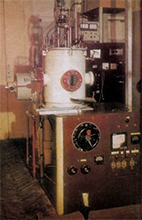
Installation of quenching of melted metals by superfast rates
First were obtained thin films of boron and its alloys with transition metals in ultra-high-rate cooling (≈106deg/s) from the liquid phase (G.F. Tavadze). Technology of production of radiationresistanceboron containers developed at the Institute, on a large scale was implemented in the Kharkiv Institute of Physics and Technology.
Semiconducting materials
In 1958, at the initiative of the Director of the Institute Acad. F.Tavadze, Mariam Kekua, the already recognized expert in the field of semiconductor materials, had formed the Laboratory for Semiconductor Materials and began research for obtaining solid solutions of germanium-silicon semiconductor system. Currently, this trend has become even more relevant in connection with the problem of so-called “solar silicon” presented by Prof. Nodar P. Kekelidze.
![]()
Laboratory of semiconductors
Self-propagating high-temperature synthesis (SHS)
In the 70s of the last century on the initiative Acad. F.N.Tavadze, in Georgia it began the investigations in the SHS direction.
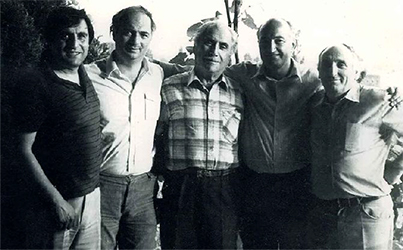
Georgian troubadours of SHS
The Institute developed SHS technology for production of refractory materials. It should be noted the receipt by a new SHS-technology the compositeceramic and metal-ceramic materials.
Physical-chemical foundations of metallurgical processes
Significant progress was made in basic research as well. Most important results were obtained in physical chemistry of metallurgical processes (G.G.Gvelesiani, I.B.Baratashvili, D.Sh.Tsagareishvili, A.A.Nadiradze, J.I.Bagdavadze). The results of these studies are reflected in number of periodicals and monographs. At different times, these works were awarded George Nikoladze, Peter Melikishvili and State Prizes.
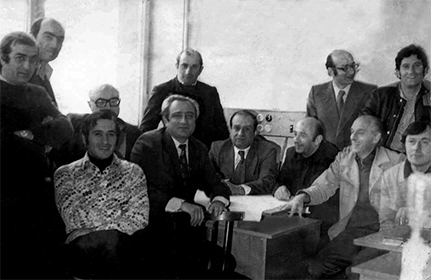
Laboratory of metallurgical processes: T.Abashidze, Z.Tsikaridze, I.Omiadze, I.Baratashvili,
D.Tsagareishvili, N.Mgaloblishvili, G.Gvelesiani, A.Nadiradze, T.Kapanadze, J.Baghdavadze,
A.Kandelaki, I.Makharadze
Published monographs in physical and chemical directions of metallurgical processes
The above presented material can be enriched with other examples:
- Over the years, the Institute directed the implementation of shrouded casting moldsin the Soviet steel mills.
- Under the leadership of the Institute, in plants it was carried out the gasification of molds based on the design developed at the Institute.
In the former Soviet Union, the Institute was considered as a leading organization in the solution of a set of scientific and technical problems. Therefore, it is no coincidence that in 1986 the Institute was earned the highest rating and received the banner of the Academy of Sciences of the USSR; and then this act was personally congratulated to Institute by President of the Academy of Sciences of the USSR Acad. Anatoly Alexandrov.
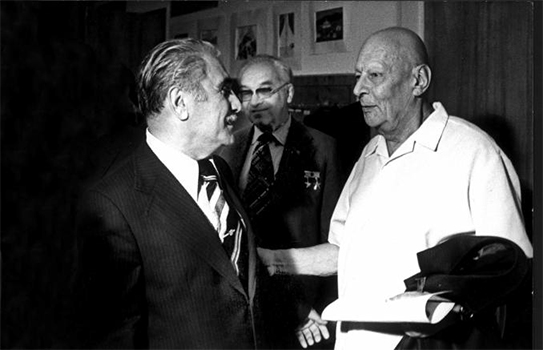
President of the Academy of Sciences of the USSR Acad. Anatoly Alexandrov personally
congratulated the Institute on receiving the banner of the Academy of Sciences of the USSR
From 1945 until today, the Institute led:
1945–1951 – Acad. of the Georgian Academy of Sciences Raphiell I. Agladze
1951–1989 – Acad. of the Georgian Academy of Sciences Ferdinand N. Tavadze
1989–1991– Dr. in Tech. Sci. Tengiz I. Sigua
1991–2006– Corr.-Member of the National Academy of Sciences of Georgia Ilia B. Baratashvili
2006-until today – Academician of Georgia NAS D.t.s., Professor Giorgi F. Tavadze
